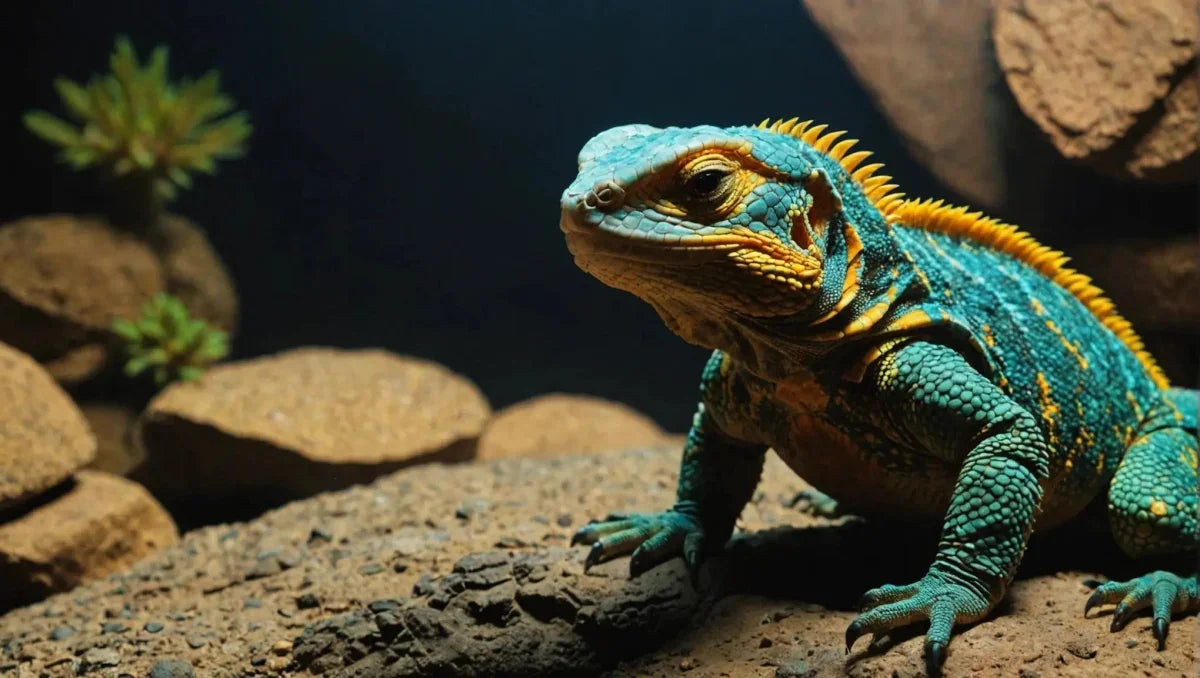Providing Optimal Lighting for Your Uromastyx Companion

Discover the key elements of providing optimal lighting for your Uromastyx companion with this comprehensive guide. As cold-blooded reptiles, Uromastyx rely on external UVB sources for their physiological well-being. This guide is designed to empower Uromastyx owners with the essential knowledge to create the ideal UVB environment. From understanding the significance of UVB light in Uromastyx health to exploring the diverse range of UVB bulbs available, every aspect is covered. The guide also provides insights into the correct positioning of UVB lights within the enclosure and common mistakes to avoid. By the end, you will have the confidence to make well-informed decisions about UVB lighting, ensuring the long-term health and happiness of your Uromastyx.
Understanding UVB Lighting
What is UVB Light?
Why UVB Light is Essential for Uromastyx
The Importance of Proper UVB Exposure
UVB light, or ultraviolet B radiation, is a critical component of a Uromastyx's overall well-being. In their natural habitat, these reptiles rely on UVB rays to synthesize vitamin D3, which is essential for calcium metabolism and bone health. Without adequate UVB exposure, Uromastyx can suffer from debilitating conditions such as metabolic bone disease, leading to skeletal deformities and other serious health issues.
Key Factors for Providing UVB Lighting
When keeping Uromastyx in captivity, it's crucial to replicate their natural UVB exposure as closely as possible. This involves using specialized reptile lights that emit UVB radiation. These lights should be carefully positioned within the enclosure to ensure that the Uromastyx can effectively bask and absorb the UVB rays. It's important to note that not all UVB lights are created equal, and it's essential to select bulbs that provide the appropriate UVB intensity and spectrum for Uromastyx, based on their species and geographic origin.
Understanding UV Index and Basking Sites
To ensure proper UVB exposure for Uromastyx, it's vital to consider the UV index and the availability of suitable basking sites within the enclosure. Different species of Uromastyx have varying UVB requirements, and it's essential to research and understand the specific needs of the species in your care. Providing a range of basking sites at different heights and temperatures allows Uromastyx to regulate their UVB exposure according to their individual requirements.
Monitoring UVB Exposure and Health
Regularly monitoring UVB levels within the enclosure and the Uromastyx's behavior and physical condition is essential. Overexposure to UVB radiation can also have adverse effects, leading to conditions such as photokeratoconjunctivitis. By carefully managing UVB exposure and providing appropriate basking sites, Uromastyx can thrive in captivity and maintain optimal health and well-being.
Selecting the Right UVB Lighting for Your Uromastyx
Understanding UVB Lighting for Uromastyx
Selecting the right UVB lighting for your Uromastyx is crucial for their overall well-being and health. UVB lighting plays a vital role in replicating the natural environment of Uromastyx and is essential for their physiological processes, including calcium metabolism and overall growth and development.
Types of UVB Lighting for Uromastyx
There are various types of UVB lighting available in the market, each with its own set of advantages and considerations. - Fluorescent tubes are a popular and cost-effective option, providing a widespread UVB output. However, they need to be replaced every 6-12 months to maintain their effectiveness. - Compact fluorescent bulbs are a space-saving alternative, also requiring replacement every 6-12 months. - Mercury vapor bulbs are another option, emitting both UVB and heat, making them suitable for desert reptiles like Uromastyx. While they are more expensive, they offer a longer lifespan, typically needing replacement annually.
Factors to Consider when Choosing UVB Lighting for Uromastyx
When selecting UVB lighting for your Uromastyx, several factors need to be taken into account to ensure optimal lighting conditions. - The size of the enclosure determines the strength of the UVB bulb needed to provide adequate coverage. - The distance between the bulb and your pet is critical, as it directly impacts the amount of UVB exposure your Uromastyx receives. - Understanding the specific UVB requirements of Uromastyx is essential for providing the right lighting conditions to support their overall health and well-being. It is crucial to research and consult with experienced reptile veterinarians or breeders to determine the most suitable UVB lighting for your Uromastyx.
Additional Considerations
In addition to the type and placement of UVB lighting, it's important to consider the overall lighting setup in the enclosure. Providing a gradient of light and shade allows Uromastyx to regulate their exposure, mimicking their natural behavior in the wild. Regularly monitoring the UVB output using appropriate meters is also essential to ensure that the lighting conditions remain optimal for your pet. By carefully considering the types of UVB lighting available and the specific needs of your Uromastyx, you can provide them with optimal UVB exposure, contributing to their overall health and happiness.
UVB Requirements for Uromastyx Species
Uromastyx lizards are highly dependent on UVB light for their overall health and well-being. In their natural habitats, these reptiles bask in the sun, absorbing essential UVB rays to maintain proper bone development and metabolic functions.
The Importance of UVB for Uromastyx Health
UVB light plays a crucial role in the synthesis of vitamin D3, which is essential for calcium absorption in reptiles. Inadequate UVB exposure can lead to serious health issues such as metabolic bone disease (MBD) in Uromastyx lizards, causing deformities and even death in severe cases.
Variations in UVB Needs Among Different Uromastyx Species
It's important to note that the UVB requirements may vary among different Uromastyx species based on their natural habitats. Desert-dwelling Uromastyx species, such as Uromastyx ornata and Uromastyx aegyptia, require intense UVB exposure, mimicking the strong sunlight found in arid environments. On the other hand, forest-dwelling Uromastyx species, like Uromastyx ocellata, may have slightly different UVB needs due to the filtered sunlight in their native habitats.
Choosing the Best UVB Lighting Options for Uromastyx Enclosures
When creating a captive environment for Uromastyx lizards, providing adequate UVB lighting is crucial. Opt for high-quality UVB bulbs specifically designed for reptiles, ensuring that the light spectrum and intensity cater to the specific needs of your Uromastyx species. Additionally, consider the size of the enclosure and the distance between the UVB source and basking spots to guarantee proper UVB exposure for your pet.
The Importance of Temperature and UVB
In addition to UVB lighting, maintaining proper basking temperatures is essential for Uromastyx health. These reptiles require high basking temperatures to aid in digestion and regulate their metabolism. When combined with the appropriate UVB exposure, the right basking temperatures contribute to the overall well-being of Uromastyx species.
Monitoring UVB Exposure
Regularly monitor the UVB output of the bulbs in the Uromastyx enclosure, as UVB potency decreases over time. Replace the UVB bulbs as recommended by the manufacturer to ensure that your pet receives adequate UVB exposure for optimal health.
By understanding and meeting the UVB requirements of Uromastyx species, reptile enthusiasts can ensure the optimal health and vitality of their beloved pets.
Setting Up UVB Lighting
Placement of UVB Lights
When setting up UVB lighting for your reptile enclosure, it’s crucial to consider the placement of the lights. Position the UVB lights over a basking spot where your reptile can access them easily. This will ensure that your pet receives the necessary UVB radiation to support its overall health.
Creating a UVB Gradient in the Enclosure
Creating a UVB gradient in the enclosure is also essential. This involves providing varying levels of UVB exposure throughout the habitat, allowing your reptile to self-regulate its UVB intake. Consider using different strength UVB bulbs or adjusting the distance of the lights from basking areas to achieve this gradient.
Additionally, it’s important to monitor the effectiveness of the UVB lighting over time. UVB bulbs degrade and lose their potency, so regular replacement is necessary to maintain optimal UVB levels for your reptile.
By carefully setting up and maintaining UVB lighting, you can create a healthy and comfortable environment for your reptile to thrive.
When positioning the UVB lights, it's important to ensure that there are no barriers, such as glass or plastic, between the light source and your reptile. These materials can block UVB rays, hindering the reptile from receiving adequate exposure. It's also vital to consider the natural behaviors of your reptile species and position the UVB lights to mimic their natural habitat. For instance, arboreal species may require UVB lights placed higher in the enclosure to simulate their natural basking environment.
Creating a UVB gradient is not only about varying the strength of UVB bulbs but also about providing shaded areas within the enclosure. This allows the reptile to move in and out of the UVB exposure as needed, regulating its intake. Natural decor and foliage can be utilized to create these shaded areas, contributing to a more naturalistic and enriching environment.
Regularly assessing the UVB output using a solar meter is essential for ensuring that the lights are providing adequate levels of UVB radiation. This measurement helps in determining the effectiveness of the bulbs over time and guides the necessary adjustments in positioning or bulb replacement.
In addition to UVB lighting, it's crucial to provide a suitable heat source for your reptile, as UVB and heat work together to support essential biological processes. Maintaining proper temperature gradients in the enclosure is vital for your reptile’s overall well-being. It's recommended to consult with a reptile specialist or veterinarian to ensure the specific UVB and heat requirements for your reptile species are met.
Maintaining UVB Lighting
Significance of Regular UVB Bulb Replacements
UVB bulbs are essential for reptiles as they provide the necessary UVB radiation critical for various physiological functions, including calcium metabolism and overall health. Over time, UVB bulbs degrade, resulting in decreased UVB output, which can significantly impact your reptile's health. Therefore, it is imperative to adhere to a schedule for replacing UVB bulbs, typically every 6 to 12 months, depending on the specific bulb type and manufacturer's guidelines.
When replacing UVB bulbs, it is crucial to select high-quality bulbs suitable for your reptile's species and enclosure size. Ensure to consider the recommended UVB output levels for your reptile's specific species to provide the most suitable lighting conditions. Moreover, it’s important to check for any signs of wear or discoloration in the bulb, as this can indicate a decrease in UVB output, warranting an earlier replacement to maintain the optimal lighting conditions for your reptile.
Importance of Monitoring UVB Output
In addition to regular bulb replacements, monitoring the UVB output is equally important. Utilize a UV meter to measure the UVB output within your reptile's habitat. This tool will help you assess the effectiveness of the UVB bulbs and ensure that your reptile is receiving the required UVB radiation.
Regularly check the UVB output levels to verify that they are within the optimal range for your reptile species. If the readings indicate a decrease in UVB output, it may be necessary to replace the bulb earlier than scheduled to maintain the appropriate lighting conditions for your reptile.
By prioritizing regular UVB bulb replacements and diligently monitoring the UVB output, you can safeguard your reptile's health and well-being, ensuring they receive the essential UVB radiation necessary for their physiological processes and overall vitality. These measures play a vital role in simulating natural lighting conditions, promoting natural behaviors, and supporting optimal health for your reptile.
Proper UVB lighting is crucial for the health and well-being of Uromastyx lizards. By providing the correct UVB lighting, Uromastyx owners can ensure that their pets receive the necessary UVB radiation to support their physiological and behavioral needs. It is important to carefully consider the specific requirements of Uromastyx lizards and invest in high-quality UVB lighting to create a suitable habitat for these unique reptiles.





